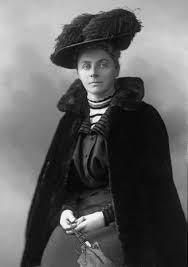In 2024 ‘The Story of Emily’, a museum dedicated to Emily Hobhouse, opened in St Ive, near Liskeard but who was this formidable Cornish woman and why is her life and legacy worth remembering?
Emily Hobhouse was a humanitarian, a pacifist and a feminist who challenged the socially accepted standards of the Victorian society she lived in. She championed the rights of women, of the poor and of what she referred to as the “down-trodden stranger”. But she is perhaps best remembered for challenging the establishment on their horrific treatment of the people of South Africa during the Boer War. For this she was called a “hysterical woman” and a “traitor”.
Emily was born in the Rectory in St Ive, the building now houses her museum, in 1860 and lived there for the first 34 years of her life. In 1895 after the death of her parents she travelled to America to participate with welfare work amongst the Cornish miners that were living there. She became engaged out there but the relationship was brief and Emily returned to England unmarried, from then on she devoted her life to humanitarian and feminist causes.
Emily Hobhouse devoted her life to humanitarian and feminist causes
When the Second Boer War broke out in 1899 Emily soon “learnt of the hundreds of Boer women that became impoverished and were left ragged by our military operations”. She founded the ‘South African Women and Children Distress Fund’ and sailed for Cape Town in December 1900. She was horrified by what she discovered – thousands of women and children living in Concentration Camps run by the British armed forces, who were suffering in terrible conditions which were resulting in starvation, disease and death.

When she pointed out the misery of the camps to those in charge and suggested some simple improvements such as rations of milk for the children, soap to wash and more kettles to boil water, little to nothing was done to improve conditions. In fact, the British soldiers and command made it clear that they regarded her as “a fool, an idiot and a traitor combined”.
But Emily refused to remain silent, she returned to England and began reporting what was happening to anyone who would listen, and those who didn’t want to, saying “I call this camp system a wholesale cruelty . . . to keep these camps going is murder to the children.”
In an era when women were expected to remain quiet and submissive Emily was dogged and vocal. Against a great deal of criticism and hostility she published damning reports, led social reforms, and single-handedly challenged the deaf ears of the British establishment. She wrote:
“Crass male ignorance, stupidity, helplessness and muddling. I rub as much salt into the sore places of their minds as I possibly can, because it is so good for them . . .”
The British Government eventually agreed to set up the Fawcett Commission to investigate her claims. The Commission corroborated her account of the shocking conditions in the camps but Emily’s part in bringing these human rights violations to light was never acknowledged.
Hobhouse continued with her humanitarian work in South Africa for the rest of her life and became a national heroine there. She was made an honorary citizen and when she died in 1926 her ashes were ensconced in a niche inside the National Women’s Monument at Bloemfontein. This monument depicts a group of bronze figures, two grieving women and a dying child, and the design is taken directly from a sketch made by Emily of a tragic screen that she witnessed on 15 May 1901 while a visiting to one of the camps.
You can discover more about Emily Hobhouse’s life and the story of the Boer War camps at The Story of Emily museum in St Ive.
